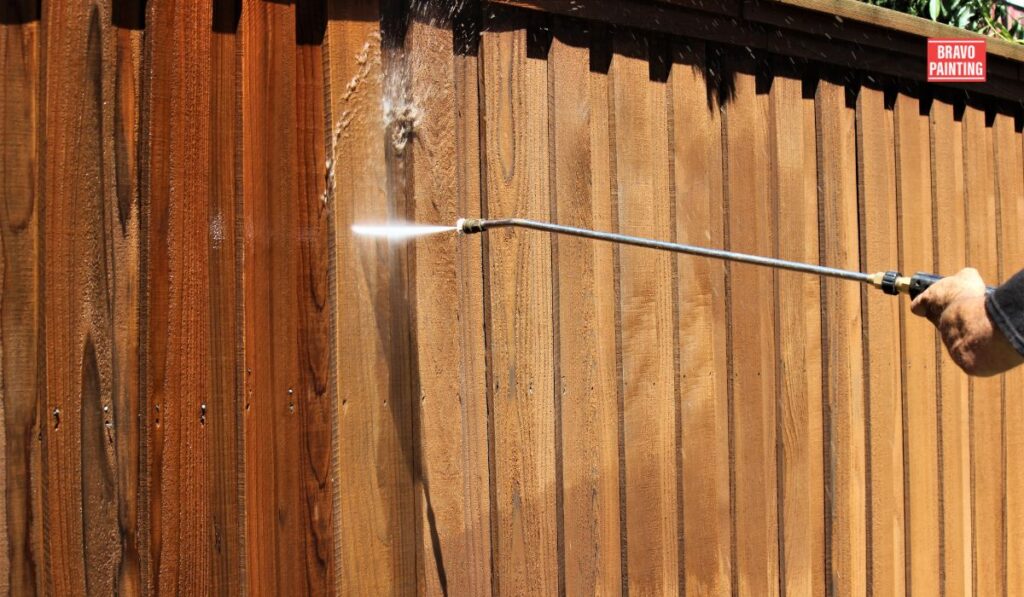Wood fences are a classic addition to any property, providing privacy, security, and an attractive aesthetic.
However, to maintain their beauty and longevity, regular maintenance, including staining, is essential.
Staining not only enhances the wood’s natural appearance but also protects it from the elements, preventing rot, decay, and weather damage.
Here’s a comprehensive guide to wood fence staining, covering everything you need to know before getting started.
Understanding the Importance of Staining
Staining a wood fence is crucial for several reasons:
- Protection from Elements: Stain acts as a barrier against moisture, UV rays, and temperature fluctuations, which can cause the wood to warp, crack, and fade.
- Preventing Rot and Decay: Stain helps prevent rot and decay caused by prolonged exposure to moisture by sealing the wood.
- Enhancing Appearance: Stain enhances the natural grain and color of the wood, giving it a fresh, polished look.
- Increasing Longevity: Regular staining extends the life of your fence, saving you money on repairs and replacements in the long run.
Choosing the Right Stain
Selecting the right stain for your fence is essential. Here are the main types to consider:
- Transparent Stains: These stains provide minimal color and allow the natural beauty of the wood to shine through. They offer essential protection against the elements.
- Semi-Transparent Stains: These provide a hint of color while still showcasing the wood grain. They offer better protection than transparent stains.
- Solid Stains: These stains offer the most coverage and protection, almost like paint. They are ideal for older fences or wood that needs more coverage due to imperfections.
When choosing a stain, consider the type of wood, the desired look, and the level of protection needed. Oil-based stains penetrate deeper and provide long-lasting protection, while water-based stains are easier to clean and more environmentally friendly. If you’re unsure which stain is right for your fence, it’s always best to consult premier staining services for expert advice.
Preparing Your Fence
Proper preparation is critical to a successful staining job. Follow these steps:
- Cleaning: Clean the fence thoroughly to remove dirt, mold, mildew, and old stain or paint. Use a wood cleaner or a mixture of bleach and water. A pressure washer can also be effective, but use it carefully to avoid damaging the wood.
- Sanding: Sand the fence to create a smooth surface for the stain to adhere to. This step is crucial if the wood is rough or has old stain residue.

- Repairing: Inspect the fence for any damaged or rotting sections and repair or replace them as needed.
- Drying: Ensure the fence is completely dry before applying the stain. Moisture in the wood can prevent the stain from adhering correctly.
Staining Process
With your fence prepared, you’re ready to start staining:
- Choosing the Right Tools: Use a high-quality brush, roller, or sprayer. Brushes and rollers are ideal for smaller areas or detailed work, while sprayers are great for covering large areas quickly.
- Application Technique: Apply the stain in the direction of the wood grain to ensure even coverage. Start from the top and work your way down to prevent drips and streaks.
- Number of Coats: Depending on the type of stain and the desired finish, you may need to apply multiple coats. Allow each coat to dry completely before applying the next one.
- Final Touches: After staining, inspect the fence for any missed spots and touch them up as needed. Clean your tools immediately to prevent the stain from hardening on them.
Maintenance Tips
To keep your fence looking great and ensure its longevity, follow these maintenance tips:
- Regular Inspections: Check your fence periodically for signs of wear, damage, or mildew. Address any issues promptly to prevent further deterioration.
- Cleaning: Clean your fence annually to remove dirt, debris, and mildew. This will help maintain the stain’s effectiveness and appearance.
- Reapplying Stain: Depending on the type of stain and exposure to elements, you may need to reapply the stain every 2-5 years. Transparent and semi-transparent stains generally require more frequent reapplication than solid stains.
Additional Tips and Tricks
Here are some extra pointers to ensure your staining project goes smoothly:
- Weather Conditions: Choose a dry, mild day for staining. Avoid staining when it’s too hot, too cold, or rainy. The ideal temperature range is between 50°F and 85°F.
- Test the Stain: Before applying the stain to the entire fence, test it on a small, inconspicuous area to ensure you’re happy with the color and finish.
- Brush Quality: Invest in a high-quality brush designed for staining. Cheap brushes can shed bristles and leave streaks, affecting the final look.
- Protect Surroundings: To prevent accidental stain splatters, cover nearby plants, grass, and structures with plastic sheeting or drop cloths.
- Use Drop Cloths: Place drop cloths or cardboard at the base of the fence to catch drips and prevent stains on the ground.
Common Mistakes to Avoid
Avoid these common pitfalls to ensure a professional-looking finish:
- Skipping Preparation: Inadequate cleaning and preparation can lead to poor stain adhesion and an uneven finish.
- Overapplication: Applying too much stain can cause it to pool and create sticky, unattractive spots. Apply thin, even coats.
- Inconsistent Coverage: Ensure each section is evenly coated before moving on to the next to avoid patchy areas.
- Ignoring Drying Times: Rushing the process can ruin the finish. Allow sufficient drying time between coats and after the final application.
Conclusion
Staining your wood fence is a worthwhile investment that enhances its beauty and durability.
By choosing the right stain, preparing the wall properly, and applying the stain correctly, you can protect your fence from the elements and enjoy its benefits for years to come.
Regular maintenance will keep your fence looking fresh and ensure it continues to provide privacy, security, and curb appeal to your property.

So, roll up your sleeves, gather your materials, and get started on giving your fence the care it deserves.
Whether you’re a first-time DIYer or an experienced handyman, following these steps will help you achieve a professional-quality result that will keep your wood fence looking great and performing well for many years.
If you prefer professional assistance with your fence staining project, consider reaching out to Bravo Painting for expert help and exceptional results.
FAQs
Why is staining a wood fence important?
Staining protects the wood from moisture, UV rays, and temperature fluctuations, preventing warping, cracking, and fading. It also helps prevent rot and decay, enhances the wood’s natural appearance, and increases the fence’s longevity.
What types of stains are available for wood fences?
- Transparent Stains: Provide minimal color and elemental protection, allowing the natural wood grain to show.
- Semi-Transparent Stains: Offer a hint of color while showcasing the wood grain, providing better protection.
- Solid Stains Offer the most coverage and protection, similar to paint. They are ideal for older fences or wood with imperfections.
How do I choose the right stain for my fence?
Consider the type of wood, the desired look, and the level of protection needed. Oil-based stains penetrate deeper and provide long-lasting protection, while water-based stains are easier to clean and more environmentally friendly.
What are the steps to prepare a fence for staining?
- Cleaning: Use a wood cleaner or a mixture of bleach and water to remove dirt, mold, mildew, and old stain/paint. A pressure washer can also be used carefully.
- Sanding: Sand the fence for a smooth surface.
- Repairing: Fix any damaged or rotting sections.
- Drying: Ensure the fence is completely dry before staining.
What tools are needed for staining a wood fence?
Use a high-quality brush, roller, or sprayer. Brushes and rollers are suitable for small areas or detailed work, while sprayers are excellent for large areas.
How should I apply the stain?
Apply the stain in the direction of the wood grain, starting from the top and working your way down. Apply thin, even coats and allow each coat to dry completely before applying the next one.
How many coats of stain should I apply?
The number of coats depends on the type of stain and the desired finish. Multiple coats may be needed for optimal protection and appearance.
What are some maintenance tips for a stained wood fence?
- Regular Inspections: Check periodically for signs of wear, damage, or mildew.
- Cleaning: Clean annually to maintain the stain’s effectiveness and appearance.
- Reapplying Stain: Reapply stain every 2-5 years, depending on the type and exposure to elements.
What are the best weather conditions for staining?
Choose a dry, mild day for staining, ideally between 50°F and 85°F. Avoid staining in extreme heat, cold, or rain.
How can I avoid common staining mistakes?
- Preparation: Ensure proper cleaning and sanding for good stain adhesion.
- Application: Apply thin, even coats to avoid pooling and sticky spots.
- Coverage: Ensure even coverage for a consistent finish.
- Drying Times: Allow sufficient drying time between coats and after the final application.
Are there any additional tips and tricks for staining a fence?
- Test the stain on a small area to ensure the desired color and finish.
- Invest in a high-quality brush to avoid bristle shedding and streaks.
- Protect nearby plants, grass, and structures with plastic sheeting or drop cloths.
- Use drop cloths or cardboard at the base of the fence to catch drips.


